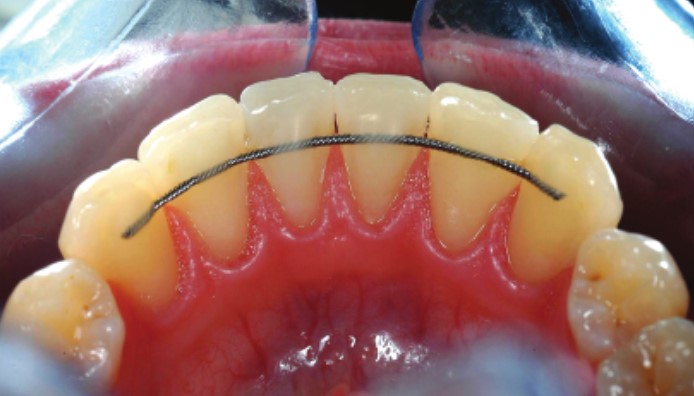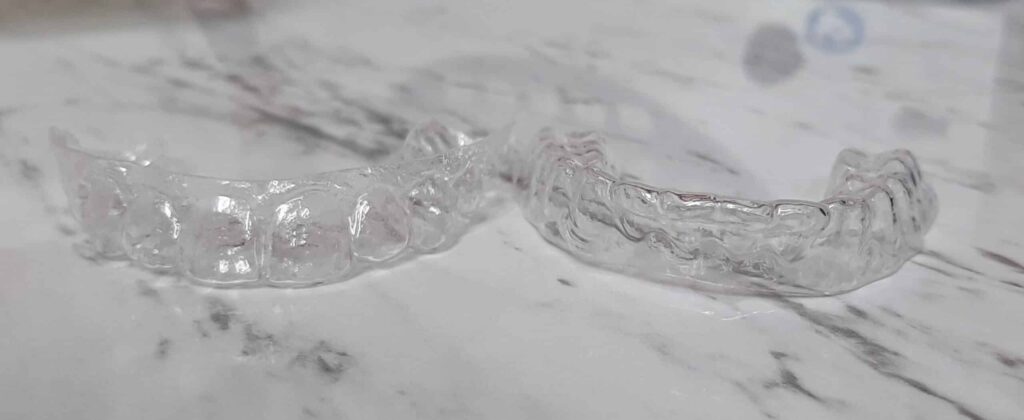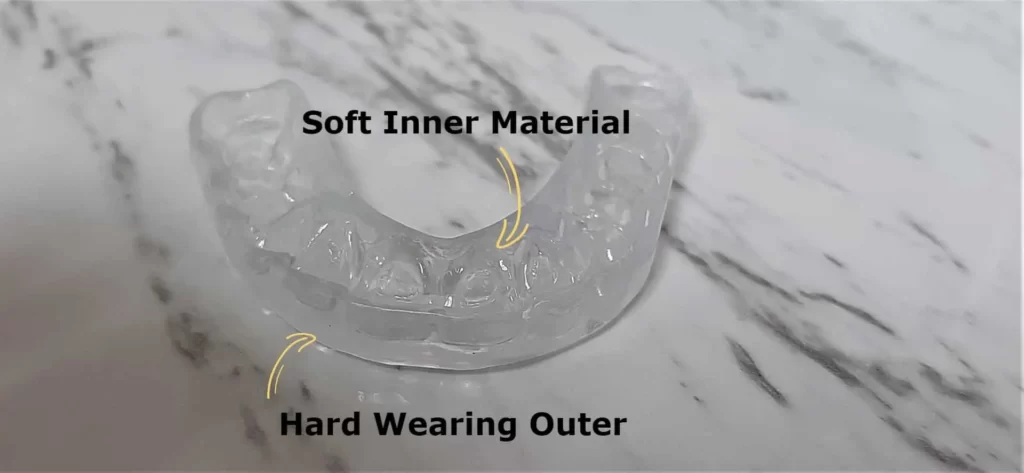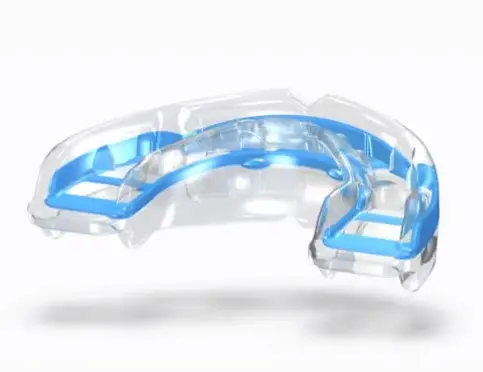Removable Appliances
Retainers
Retainers are required after orthodontic treatment such as traditional braces or clear aligner solutions such as Invisalign.
After the completion and removal of braces, teeth would tend to move back to their original position and this is where retainers come in! Your dentist will advise you on the frequency and duration that you should wear your retainers post-treatment.
Types of Retainers
There are three main types of retainers:

Removable Clear Plastic Retainers
Made from FDA approved plastic material, these retainers are made by thermoforming plastic over a model of your teeth taken during your dental visit. They are commonly known as clear/invisible retainers. From Dec 2024, we only use Zendura which is considered the toughest and longest lasting clear retainer material.
Pros:
- Virtually invisible to onlookers
- Retains teeth well, allowing minimal movement
- Can be easily removed to clean
- Easy access to clean teeth without retainers interfering
Cons:
- Discolouration over time is more visible.
- Shorter lifespan
- Can be chewed through if the patient is a tooth grinder (bruxer)
- Cannot eat with the retainer in place

Removable Hawley Retainers (Wire Retainers)
Made from a plastic base with a thin piece of metal wire. The base is custom fit according to each individual’s mouth.
Pros:
- Lasts a longer time compared to clear retainers
- No need to remove while eating / no risk of losing retainers after mealtime
- Might be repairable
- Long track record – tried and tested.
Cons:
- The wire is visible when worn
- Affects speech more than clear retainers at first (1-2 weeks) before you get used to it
- Allows some tooth movement

Fixed Lingual Retainers
These retainers utilise a metal wire that is attached permanently to the back of your front teeth to hold your teeth in position.
Pros:
- Don’t have to remember to wear them
- Cannot be misplaced
- Lasts a long time
- Invisible to onlookers
- Does not affect speech
Cons:
- Bonding of attachments to hold the wire to the tooth surface may require repair/replacement at some point
- The metal wire interferes with flossing, and invariably there is more tartar buildup around teeth with fixed lingual retainers
- Higher upfront cost
Cost of Retainers
Costing depends on the type of material used for the retainer, with the cost documented in the table below.
Take note that a full mouth consists of 2 arches: upper arch and lower arch.
Retainers are not subsidised by CHAS.
Retainers
- Clear Retainers: from $350/ arch
- Hawley Retainers: $500/ arch
- Fixed Lingual Retainers: $600/ arch
What To Expect
First Visit (~30 mins):
A model of your mouth will be captured by either a 3D scanner or an impression. That’s it for you! The retainer will then be made according to your teeth alignment.
Second Visit a Week Later (~15 mins for Removable Retainers/ ~30 mins for Fixed Retainer):
Clear and Hawley retainers: The completed retainer will be fitted to verify proper function and passed to you with care instructions given.
Fixed Lingual Retainers: The metal wire bent to the shape of your teeth would be bonded onto the lingual (tongue side) portion of your teeth.
Nightguards / Mouthguards
Nightguards, also known as mouthguards or bite splints is a device that prevents your teeth from wearing each other out when you grind your teeth together unknowingly/ involuntarily while sleeping. This condition is known as bruxism.
Studies have shown that roughly 1 in 3 people grind their teeth in their sleep, and bruxism may account for 50% of neck pain/ headaches/ toothache in the population.
Wearing a custom night guard protects the teeth from excessive wear and can relieve pain and discomfort in the teeth, facial muscles, and jaw joints.
Types of Nightguards

Regular Nightguards
A rigid nightguard that is thermally formed and custom moulded to your jaw.
Key features:
- Non-flexible
- Moderately durable depending on grinding severity
- Able to prevent teeth from shifting due to the rigid nature

Bilaminate / Dual Laminate Nightguard
These nightguards are made of two layers: a soft inner layer in contact with your teeth, and a hard outer layer hence the name dual laminate.
Key Features:
- More comfortable to wear due to the softer inner layer compared to regular nightguards
- More durable because of the hard outer layer which is thicker
At Clement Dental, we only offer Bilaminate / Dual Laminate Nightguards.
Custom Vs Store-Bought Nightguards
With nightguards available off-the-shelf at retail pharmacies/ grocery stores at a lower price compared to custom-made nightguards by a dentist, you may be tempted to opt for the cheaper option.
Here are a few reasons why a custom nightguard is worth it despite the price difference:
- Custom-fit: Every individual has a unique tooth and mouth structure. Store-bought nightguards are made to fit the masses and therefore can fit many people, but not very well. Even the moldable ones do not fit well after following the manufacturer’s instructions which leads to a non-functional appliance because you can’t wear them comfortably / they can’t stay inside your mouth.
- Secure and comfortable: Due to the individual fit, custom nightguards fit like a glove and feel less bulky. Store-bought nightguards are likely to be a poor fit and may come out during sleep.
- Better quality & more durable: Custom nightguards are commonly thicker and are able to withstand more wear and tear. The thickness can also be customised depending on whether you have mild or severe bruxism.
What To Expect
First Visit (~30 mins):
A model of your mouth will be captured by either a 3D scanner or an impression. That’s it for you! The nightguard will then be sent to a dental lab for fabrication.
Second Visit (~15 mins, 1 week later):
The nightguard will be fitted onto your teeth to ensure good fit and retention, relevant care instructions will be given.
Myobrace

Myobrace is a preventive pre-orthodontic treatment that focuses on addressing the underlying causes of crooked teeth, often without the need for braces or extraction of teeth, unlocking natural growth and development. This treatment is best suited to children aged 3 to 15 and involves using a series of removable intra-oral appliances that are worn for 1-2 hours each day plus overnight while sleeping.
For more information, head over to the Myobrace website HERE
What To Expect
First Visit (~30 mins):
A model of your mouth will be captured by either a 3D scanner or an impression. That’s it for you! The suitable Myobrace appliance will then be ordered and delivered.
Second Visit (~15 mins, 1-2 weeks later):
Myobrace appliance will be issued to you, along with care and usage instructions.

